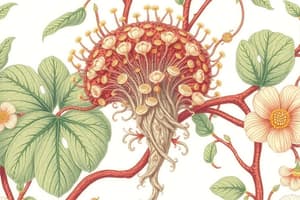Podcast
Questions and Answers
Which method is NOT recommended for managing the disease caused by this pathogen?
Which method is NOT recommended for managing the disease caused by this pathogen?
- Close planting of crops (correct)
- Rogue diseased plants
- Disinfest infected corms with hot water
- Rotate taro with other crops
What temperature range is ideal for the growth of this pathogen?
What temperature range is ideal for the growth of this pathogen?
- 20°C to 25°C
- 28°C to 30°C (correct)
- 32°C to 35°C
- 10°C to 15°C
How does the pathogen primarily get distributed in the environment?
How does the pathogen primarily get distributed in the environment?
- By splashing water, wind, and rain (correct)
- Via human activity
- Through animal transport
- Through soil erosion
What condition can lead to the formation of oospores for the pathogen?
What condition can lead to the formation of oospores for the pathogen?
What is the purpose of amending soil with lime material before planting?
What is the purpose of amending soil with lime material before planting?
What is the primary causal organism of phytophthora leaf blight of colocasia?
What is the primary causal organism of phytophthora leaf blight of colocasia?
Which environmental condition is most favorable for the growth and spread of Phytophthora colocasiae?
Which environmental condition is most favorable for the growth and spread of Phytophthora colocasiae?
What type of spores does Phytophthora colocasiae primarily produce for reproduction?
What type of spores does Phytophthora colocasiae primarily produce for reproduction?
In what range of temperatures does Phytophthora colocasiae grow optimally?
In what range of temperatures does Phytophthora colocasiae grow optimally?
What is a notable characteristic of the early stage symptoms of Phytophthora leaf blight?
What is a notable characteristic of the early stage symptoms of Phytophthora leaf blight?
How do zoospores from Phytophthora colocasiae interact with the environment after swimming?
How do zoospores from Phytophthora colocasiae interact with the environment after swimming?
What is the result of merging A1 and A2 mating types of Phytophthora colocasiae in a culture dish?
What is the result of merging A1 and A2 mating types of Phytophthora colocasiae in a culture dish?
Which of the following describes a symptom of advanced Phytophthora leaf blight?
Which of the following describes a symptom of advanced Phytophthora leaf blight?
Flashcards are hidden until you start studying
Study Notes
### Phytophthora Leaf Blight of Colocasia
- Phytophthora leaf blight, caused by the fungus Phytophthora colocasiae, is a significant threat to taro production, leading to yield losses of 25-50%.
- The pathogen also infects taro corms, causing post-harvest decay.
- The disease was first reported in India in 1905 and has been observed at various locations in the country.
- The fungus produces asexual spores called sporangia and sexual spores called oospores.
- Sporangia are oval, semi-papillate, deciduous, and have a short stalk.
- They release swimming spores called zoospores when water is present.
- Sporangia can germinate directly or indirectly, forming germ tubes.
- Zoospores can swim for hours, attracted to organic matter or host tissue, before encysting and producing a germ tube to penetrate the host.
- The pathogen has two mating types, A1 and A2, which can produce oospores when grown together, serving as survival structures in the absence of a host.
- While oospores have not been found in nature, they have been observed in laboratory settings.
- The pathogen thrives in warm, moist environments with temperatures between 28°C and 30°C.
- Early symptoms include the formation of small, dark to light brown or olive-green spots, often at the tips and margins of leaves where water accumulates.
- Spots enlarge rapidly, becoming wilted, circular, and purplish brown to dark brown to black in color.
- On the lower surface of leaves, spots have a water-soaked or dry gray appearance.
- As spots increase in size, they merge, leading to leaf decay.
- Clear, amber liquid may be observed on the surface of infected spots.
- Infection spreads rapidly in susceptible cultivars, causing significant damage in moist weather.
- Sporangia can detach from sporangiophores at the edge of lesions and infect leaves, petioles, or taro corms in the soil.
- They spread through splashing water, wind, and rain.
- The pathogen survives as mycelium in plant tissues, as encysted zoospores in soil, and in infected corms left in the field after harvest.
- The pathogen can also spread through the movement of infected corms.
- Despite the waxy surface of taro leaves, small amounts of water accumulation are sufficient for fungal spore germination and penetration.
- In paddy culture, water movement facilitates the spread of the pathogen within and between fields.
- The fungus is believed to persist in corms or soil during dry periods.
- Management strategies include:
- Removing and destroying diseased plants.
- Avoiding close planting.
- Disinfecting corms with hot water.
- Soil preparation and amendment to meet calcium, magnesium, and phosphorus needs.
- Increasing soil pH to 6.0-6.8 by adding lime material before planting.
- Crop rotation with non-host plants.
- Incorporating compost and applying surface mulch.
Studying That Suits You
Use AI to generate personalized quizzes and flashcards to suit your learning preferences.


